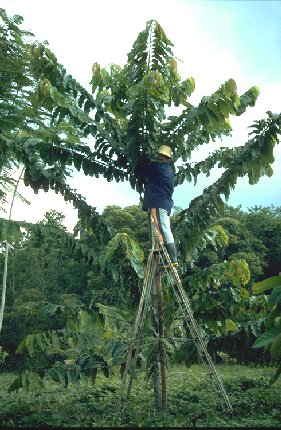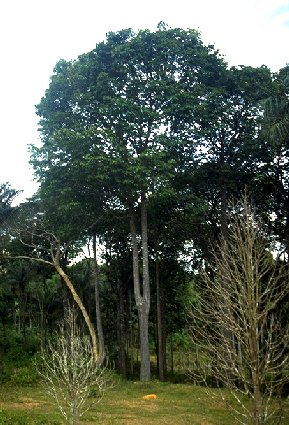Castanha (Bertholletia excelsa) species description
by Marc-A. Wolf
|
References are found here
Castanha-do-Brasil (Bertholletia excelsa H.B.K., Lecythidaceae) (or: Castanha-do-Para (Bras.), (brazil nut (Engl.), nuez del Brasil (Spanish), Paranuss (German)) is of economic importance both because of its edible nuts, which are rich in oil and protein (about 70% and 14 % of the edible part, respectively) (SUDAM-CTPTA 1976) and because of the valuable timber, resistant to rotting. The nuts are an important source of foreign exchange for Brazil 1988: 10.655t with shells (of the individual seeds) plus 7.465t without shells (Carvalho 1993) for a price of approximately $1000 per t; the nuts also contribute to the diet of the local population. Therefore, it is forbidden to cut wild castanha trees for timber; another reason for growing these trees in plantations. Traditionally, the fruit is collected from wild trees (growing usually in small groups ("castanhais") inside natural forest of the terra firme) and are opened with a machete to obtain the "nuts". Each tree produces about 100 to 150 l of brazil-nuts per year (Fernandes & Alencar 1993), which is equivalent to about 45 to 70 kg (Smith 1992). Planting of the trees in plantations is relatively new, but promising, because castanha is well adapted to the poor and acid Amazonian soils (Nepstad et al. 1990, taken from Nepstad et al. 1991). Also, the rapid growth in open sun sites speaks in favor of planting castanha commercially. Castanha is rarely attacked by pests and diseases. Smith (1992) quotes a personal communication by P. Alvim that Castanha planted in interplanting with cacao, near Manaus, seems to respond well to fertilization. The castanha tree reaches a height of about 40 m to 50 m (Max. 62m) with a diameter of the stem at its base of about 2 m (Max. 4.3 m) (Cavalcante 1991). With the site conditions being good, it begins to produce fruit after about 12 years (Cavalcante 1991). If growing in native forest, it can stay in a waiting state for several decades with a total height of only one or two meters (Kato 1995). The growth rate increases rapidly when due to treefall a light gap opens. The trees in our experiment grown in full sun reached heights up to about 8 m with an age of only four years after germination. Fig. 1 shows a young tree of the SHIFT-Experiment and an older mature exemplar near Manaus. Castanha is reported to be mainly pollinated by the euglossine, anthophorid, and apine bees of the genera Xylocopa, Bombus, Centris, Epicharis, and Eulaema (Smith 1992). Self-pollination is subject to controversy; while Müller & Calzavara (1986) state that a certain percentage occurs, this is denied by Smith (1992). The dependence on Bombus might be a problem when castanha is planted far away from Primary or higher Secondary Forest, where the species of Bombus have their nesting (Müller & Calzavara 1986). Additionally, some of the other bee species responsible for pollination depend on certain orchid species for mating (Smith 1992). Smith states, that a pronounced dry season is important for a good fruit set. The fruit takes about 12 to 14 months to ripe and then drops. (Fernandes & Alencar 1993). It is a capsular fruit weighing usually between 500g and 1500g (up to 3 kg) containing about 15 to 24 "nuts" with hard sclereid testa inside the outer cover (mesocarp) of about 5 mm to 10 mm stone cells (Cavalcante 1991). Despite the hard shell the fruit is opened by some macaws (Ara spp.) (Smith 1992). Main harvest in Manaus is between December and March, while throughout Amazônia this time span is quite different - depending on local climate. Castanha is a native species of the terra firme Amazon natural forests. Smith (1992) reports a personal communication by I. Falesi, that some populations exist in the regularly flooded "varzea". Castanha is found growing naturally from about 5o North to 14o South including Brazil, Venezuela, Columbia, Peru, Bolivia and the Guianas (Müller & Calzavara 1986). Nowadays castanha is planted commercially even in Sri Lanka and in Trinidad. Propagation of Castanha is done either by sowing its seeds (brazil nuts) or more effectively by using cuttings of mature plants is a faster method - fructification in this case was observed only 6 years or even less after planting (Cavalcante 1991). Interesting is the good capability of regeneration of the tree: about two to four months after cutting the seven castanhas at the soil surface in this experiment strong sprouting from the base of the stem was observed for all individuals. The sproutings reached a height of about 1m half a year after cutting. Smith (1992) also reports this characteristic of castanha. |
|
|
|
|
Fig. 1 Photos of a 3.5 years old castanha tree of the SHIFT-Experiment of about 6 m height (left) and of an older specimen (stem diameter approximately about 50 to 70 cm) on private property near Manaus. The appearance of castanha’s crown was quite different among the individuals of the SHIFT-Experiment; the specimen shown to the left has relative few and long branches and a section without branches about at half height. Note the double stem of the right exemplar. Whether low lateral shading triggers a genetical disposition for such a opening of the crown close to ground or whether other causes resulted in this crown architecture is unclear. Also many individuals at SHIFT showed double or triple stems; the value of the timber is then reduced. |
|
It can be derived from natural occurrence that the species grows well with temperatures being between 24 and 27oC with an annual rainfall between 1400 and 2800 mm. From growth restriction observed in the SHIFT-experiment during the drier season, it can be derived that Castanha is somewhat sensible to drought. Schmidt (1996) recommends to provide sufficient shade for young trees during the first three to four month in order to prevent damages. Later Castanha does well in full sun. Müller & Calzavara (1989) state that Castanha is mainly found on soils rich in clay; such soils are typical for terra firme although also sandy soils exist to a large extent. For the plants of the present experiment Haag (1997) [unpubl.] found a rooting pattern forming a tap-root; coarse roots were concentrated in 10 to 30 cm or 30 to 60 depths, fine roots in 0 to 10 cm but also in 10 to 30 cm depth a relevant proportion was found. Lateral extension was limited mainly to the area below the crown. With regard to allometry, the aboveground growth pattern of castanha is of interest: Halle et al. (1978) describe castanha’s architecture as determined by an orthotropic trunk meristem which shows continuous growth. Branches are inserted continuously. For the plants of our experiment growing in open field some differences were observed: a fair proportion of the trees showed double or triple stems, probably due to lack of lateral shading. The open site conditions have the effect of a loss of apical dominance (Halle et al. 1978), a problem regarding the commercial use of the timber. Branching of the individuals investigated was not necessarily regularly along the stem; this disorder in trees might possibly be caused by lack of the nutrient B (Marschner 1995) - but no further investigations have been carried out yet. Also leaf formation differed from the pattern found by Halle et al. 1978: Leaves formed in the dry season were much smaller than usual or leaf formation was even interrupted. The distance between the leaves along the branch was clearly reduced. This indicates drought-stress during the dry season at the site investigated here. Just after onset of the rainy season formation of new leaves was highest (a prolonged leaf flush was observed (personal observation), but the variation among individuals was strong, too. This observation is similar to that made by Smith (1992) who writes, that castanha has a leaf flush during the late dry season. Especially with regard to the timber production it is important to note the formation of a wide crown near to the ground instead of formation of a straight and high stem if grown in open field lacking lateral shading, which was also observed by Kato (1995) and Fernandes & Alencar (1993). Regarding allometrics this growth pattern increases the proportion of branches and leaves in total aboveground biomass compared to individuals grown under lateral shading which stronger invest into the stem to reach height. |
For citation refer to:
WOLF, M.-A. (1997). Accumulation of biomass and nutrients in the aboveground organs of four local tree species in monoculture and polyculture systems in central Amazonia. German "Diplom"-thesis [unpubl.]. Technische Universität Braunschweig.

